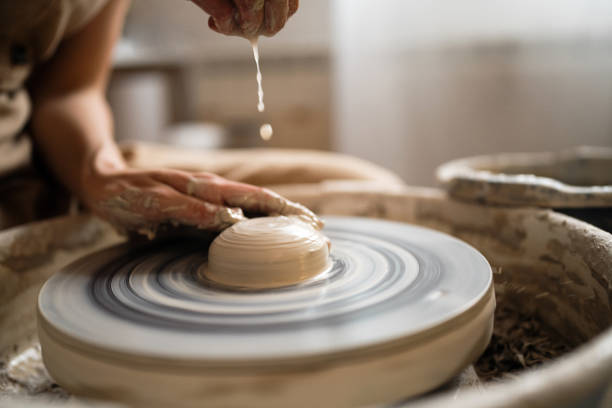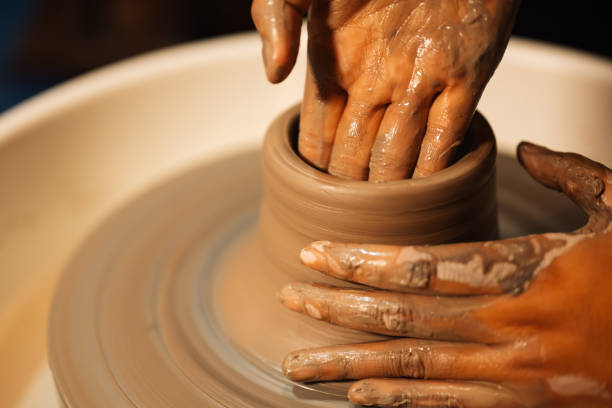A pottery wheel is a large machine that puts clay into motion. It is a crucial tool for ceramic artists, both amateur and experienced.
The best electric wheels come with a lever control. They are easier to use and give you more fine-tuned adjustments than a pedal control.
When looking for a pottery wheel and ceramic supplies, consider the space in which you’ll be working. A large studio may be able to accommodate a larger pottery wheel, but if you’re starting in your garage or basement, a tabletop model will fit better.

The Wheel
As a new potter you’re going to want to purchase a pottery wheel that is the right size for you. It needs to be large enough that you can manipulate the clay easily, but not so large that it becomes difficult to control.
You should also consider the portability of your pottery wheel. You may find it easier to work with a smaller, table top model instead of a bulky floor-mounted pottery wheel. This is especially true if you don’t have a dedicated studio space. Smaller pottery wheels are also much easier to store and take up less floor space.
Once you have your wheel and are ready to begin, make sure that it is clean and free of any grit or debris. Before you turn it on, lubricate your hands by dipping them in water to reduce friction while you work.
When you’re ready to begin, place a ball of clay on the center of your pottery wheel. Gently tap the clay into the middle with your anchor hand to prevent it from moving off center. After you’ve centered the clay, slowly increase the speed of the wheel and make sure that your arms are anchored to your legs to keep them from moving while you manipulate the clay.
It is recommended that you buy potters wheel online as it will give you the most power and responsiveness. There are many good quality pottery wheels available from brands like Shimpo, Skutt, Cowley and more.
The Clay
Clay is a natural, open-ended resource that is incredibly versatile and can support children’s holistic development in many ways. It is one of Froebel’s 20 Gifts and in the last year there has been a real focus from the staff team on the observations that are made by children when exploring this resource, this has been reflected in the high quality of the observations that have been shared.
The type of clay used can impact how the piece will turn out, especially for beginners. There are several different types of pottery clay: earthenware, stoneware and porcelain (technically there’s also ball, red clay, sand, and firing clay but they aren’t commonly used in the art of pottery). Each one is different but most are easy to work with for beginners.
It’s important to have a good workspace to work in, make sure you have an area that can be easily cleaned and that is well ventilated. It should have a sturdy table and a surface that clay won’t stick to, like canvas fabric or small drywall sheets. You should also have a bucket of water within arm’s reach along with a sponge, rib and a wire cutter.
The type of wheel you use will also affect your clay experience. Electric wheels tend to have better motors and can handle more clay than kickwheels. They are also easier to use for beginners as they don’t require the same muscle power. There are various sizes of electric wheels from compact to professional, most are able to center up to 20lb of clay but some can hold more.

The Tools
If you have decided that you’re going to pursue ceramics as a hobby, it’s worth spending the extra money on a quality pottery wheel rather than skimping out on the budget models. Pottery wheels can last for a lifetime with proper care, so choosing one that can meet your long-term needs will pay off in the end.
Electric pottery wheels are the most common choice for beginners, and they come in a variety of sizes to suit your space. If you’re limited on room, look for a small tabletop wheel that can be easily folded away when not in use. Alternatively, you can opt for a free-standing model with a larger diameter and more power.
Another important consideration is the pottery wheel’s clay centering capacity. While the amounts that manufacturers quote for this are not always accurate, a higher capacity means more power and control. The best way to test out a pottery wheel’s power is to ask if it has variable speed control, as this feature can make or break your experience on the wheel.
Most pottery wheels also come with a removable bowl, which makes transferring clay from your hands to the wheel easier and safer. Some also have a lever control that allows you to adjust the speed of the rotation with your fingers instead of using a foot pedal.
The Equipment
When it comes to purchasing your pottery wheel it’s worth doing some research – both online and locally. Most retailers such as Cromartie Hobby Craft will welcome you in to try a variety of different wheels and if you have the opportunity this will help you make a better decision. If you’re it may be worth bringing someone who is mechanically minded with you to check the condition. A wheel which is not 100% can be a real setback for a new potter and can knock your confidence.
The main thing to consider when choosing a Pottery Wheel is the Motor (Powerhouse) and its Centering capacity. Cheaper wheels tend to have a lower spec which can be a problem if you plan on making larger pieces as they may not have the torque (power) required.
When looking for a Motor it’s worth noting the RPM that it can handle and the number of revolutions per minute it can achieve – a higher figure is always a good thing as it will allow you to work faster and with greater control. Another important consideration is whether the motor has a variable speed function. This is a handy feature to have as it will enable you to slow down and then accelerate the clay as needed, rather than having to manually control each movement.